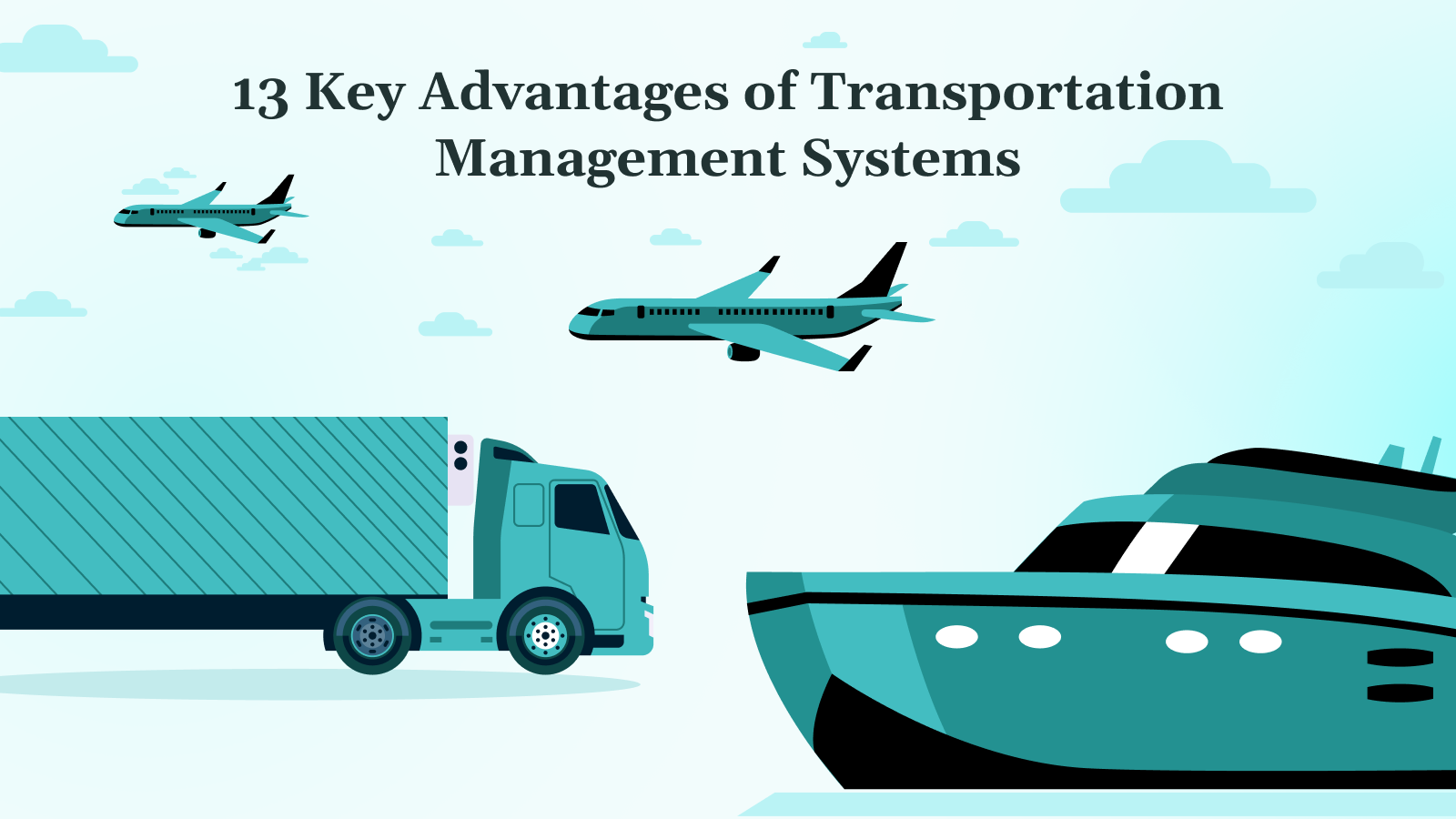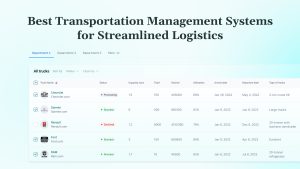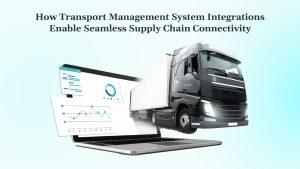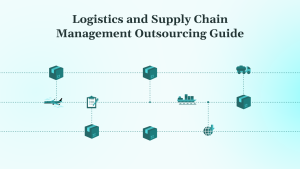Are you losing money and time because your transportation system is disorganized? We understand the challenges. Inefficiencies in transportation management lead to increased costs, missed deadlines, and poor customer satisfaction. These issues hurt your bottom line and hinder business growth.
A Transportation Management System (TMS) can solve these problems by streamlining your transportation processes. TMS centralizes everything, including route optimization, shipment tracking, inventory management, and more, helping you work smarter, not harder.
As a result, the TMS market is expected to grow from $11.75 billion in 2024 to $13.25 billion in 2025, driven by businesses looking to improve efficiency and cut costs, with a 12.8% CAGR.
In this blog, we will dive into the key advantages of a Transportation Management System. We will break down the functions, their importance, the challenges, and the solutions, providing you with a comprehensive guide to leveraging TMS for success.
Key Takeaways
- A TMS centralizes transportation operations, improving efficiency and reducing costs through automation.
- Real-time tracking and data insights offer full visibility, empowering businesses to make informed decisions.
- Cloud-based TMS is scalable, enabling businesses to grow without incurring additional infrastructure costs.
- The system optimizes routes, reduces fuel consumption, and lowers operational expenses.
- TMS enhances customer satisfaction by ensuring on-time deliveries and proactive communication.
What Is a TMS (Transportation Management System)?
A Transportation Management System (TMS) is a software solution designed to manage and optimize the movement of goods and materials. It helps businesses plan, execute, and track transportation processes. A TMS is an integral part of the supply chain, supporting operations across various transportation modes, including land, air, and sea.
At its core, a TMS helps companies choose the most efficient and cost-effective routes. It considers critical factors such as distance, delivery time, and transportation costs. By centralizing key logistics functions, a TMS allows businesses to streamline their transportation processes.
Now that we understand what TMS is, next we will explore how it operates to streamline logistics.
How Does a Transportation Management System (TMS) Work
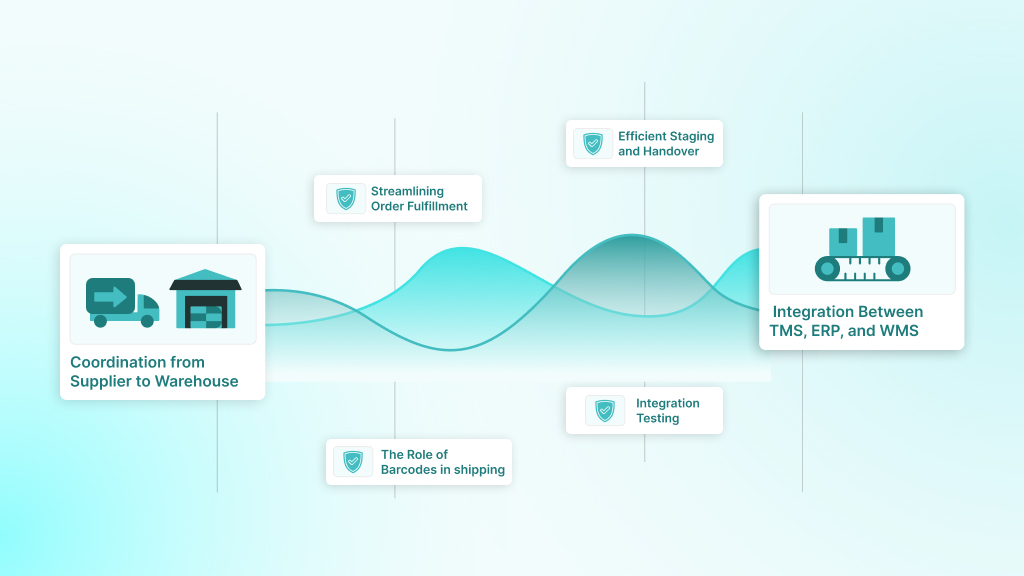
A Transportation Management System (TMS) comprises various components that work in harmony to manage and optimize the transportation process. Let us take a closer look at how a TMS works, step by step, throughout the transportation cycle.
1. Coordination from Supplier to Warehouse
The journey of goods begins well before they arrive at the warehouse. A TMS manages the movement of goods from suppliers, carefully scheduling transportation, selecting carriers, and choosing routes to ensure efficient delivery to the warehouse. It accounts for factors such as lead time, delivery schedules, and the capacity of various carriers.
Once a shipment reaches the warehouse, the TMS ensures that the facility is ready to handle it. By accurately planning deliveries, the TMS helps businesses maintain optimal stock levels and avoid disruptions in their inventory.
2. Streamlining Order Fulfillment and Consolidation
Once goods arrive at the warehouse, the TMS begins the process of order fulfillment. For example, when a customer places an order, the system consolidates items from various locations, organizing them for efficient shipping and delivery.
The TMS creates shipping labels for each order, including critical information such as destination, carrier, and shipment tracking details. It ensures that each label adheres to the requirements of the selected carrier, whether that is FedEx, UPS, or any other provider.
3. The Role of Barcodes or QR Codes in Shipping
The barcode or QR code on each package is much more than just an identifier. It holds detailed information about the shipping method, the assigned carrier, and even specific handling instructions for fragile or temperature-sensitive items.
The TMS ensures that these codes are generated correctly and comply with the carrier’s required format. When scanned, the code triggers specific actions, such as confirming shipment details or triggering updates within the system.
4. Efficient Staging and Handover
Once items are packed and labeled, they are moved to the staging area of the warehouse. This is where goods are prepped for pickup. While the Warehouse Management System (WMS) is responsible for storing inventory and organizing the warehouse layout, the TMS takes over by ensuring that each item is assigned to the correct carrier and prepared for dispatch.
For example, if a shipment requires cold chain logistics, the TMS ensures that the correct carrier with temperature-controlled services is chosen. It automates the communication with the carrier, ensuring the package is handled appropriately without needing manual intervention.
5. Integration Between TMS, ERP, and WMS
A TMS does not operate in isolation. It integrates seamlessly with other software systems, such as ERP and WMS, ensuring smooth data flow and better coordination. For instance, the ERP system tracks sales orders and inventory levels, while the WMS handles warehousing and fulfillment operations.
When an order is placed, the TMS receives data from the ERP to schedule transportation and then coordinates with the WMS to ensure the items are packed and ready for shipment. This integration ensures that all systems are aligned and working toward the same goal: delivering products efficiently and on time.
With a clear understanding of how TMS works, let us explore its core features and how they benefit your business.
Also read: Top Financial Analysis Software Tools for 2025
13 Key Advantages of Transportation Management System (TMS)
TMS offers a wide range of advantages that significantly enhance efficiency, reduce costs, and improve customer satisfaction. Let us explore the key advantages of Transport Management System in your operations.
1. Boost Operational Efficiency
A TMS automates numerous manual tasks in transportation management, helping businesses save time and reduce errors. By optimizing routes, automating carrier selection, and tracking shipments in real-time, the system accelerates workflows. This automation frees up resources, allowing companies to focus on other important areas of their business.
For example, by using TMS to optimize routes, a company can reduce miles driven and time spent on the road.
2. Better Customer Service and Satisfaction
TMS enables businesses to offer their customers real-time tracking and accurate delivery updates. By offering transparency throughout the shipping process, companies can significantly reduce customer inquiries and complaints. Customers are always informed about the location of their products and when they can expect delivery, thereby building trust and enhancing service quality.
Moreover, by optimizing delivery times and routes, TMS helps businesses meet customer expectations more effectively. This leads to higher satisfaction levels, increased loyalty, and a reputation for reliable service. TMS enables proactive communication, allowing businesses to address potential delays before customers even notice them.
3. Significant Cost Savings
Cost reduction is one of the most notable benefits of using a TMS. By optimizing routes, reducing fuel consumption, and automating administrative tasks, TMS enables businesses to lower their transportation and operational costs. According to Gartner, TMS can save a company anywhere from 5% to 10% in transportation spend.
The system evaluates carrier options and selects the most cost-effective solutions based on predefined parameters. Additionally, TMS includes features such as freight auditing and pre-billing, which help identify discrepancies and reduce the risk of overpaying.
Automated rate comparison ensures that businesses always get the best deal, reducing manual efforts and minimizing human errors. This leads to substantial savings across transportation processes.
4. Improved Supply Chain Visibility and Control
With a TMS, businesses gain complete visibility into the entire transportation process. Real-time tracking enables companies to monitor shipments at every stage, and approximately 70% of logistics firms now rely on TMS platforms for live tracking. This level of visibility helps identify potential delays or issues before they escalate, allowing businesses to take proactive action.
Additionally, TMS provides detailed data on shipping performance, enabling businesses to make informed, data-driven decisions. With better control over operations, logistics managers can effectively monitor key performance indicators (KPIs) such as on-time delivery and carrier performance, thereby enhancing overall supply chain management.
5. Increased Collaboration
A TMS enhances collaboration across departments and with external partners, such as carriers, suppliers, and brokers. By providing a unified platform for communication, it streamlines coordination between logistics teams, warehouse staff, and transportation partners.
For instance, real-time data sharing enables instant updates on order statuses and shipment tracking, improving the overall response time. This collaborative approach minimizes delays, enhances operational flow, and fosters stronger relationships with suppliers and logistics partners.
6. Sustainability
Transportation has a significant environmental impact; however, a Transportation Management System (TMS) helps businesses mitigate this by optimizing various logistics processes. With advanced algorithms and real-time data,
TMS reduces fuel consumption, emissions, and operational inefficiencies, aligning with sustainability goals. Through route optimization, load consolidation, and smart mode selection, businesses can make eco-friendly decisions that contribute to global environmental efforts.
7. Data Analytics & Insights
A TMS gathers and processes a massive amount of data from every step of the supply chain. By analyzing this information, businesses can gain valuable insights into carrier performance, delivery times, shipping costs, and other critical metrics. These insights allow businesses to make data-driven decisions, continuously improving their transportation and supply chain operations.
The robust analytics tools of a TMS also reduce the reliance on external reporting services, cutting operational costs while providing a clear view of logistics performance.
8. Scalability
As businesses grow, their logistics needs also expand. A TMS offers the flexibility to scale up as shipment volumes increase or new regions are added to the business’s operational network. Whether it is managing additional shipments, new product lines, or expanding delivery areas, a TMS can adapt to ensure that the supply chain remains optimized and efficient.
9. Aligned Dock Scheduling & Order Fulfillment
TMS enhances dock scheduling by ensuring better coordination between transportation and warehouse teams. When transportation plans are integrated with warehouse schedules, loading and unloading times are minimized, leading to smoother operations.
With a TMS, deliveries align with dock schedules, reducing waiting times and improving the efficiency of both warehouse and transportation teams.
Additionally, a TMS optimizes order fulfillment by providing real-time visibility into stock and shipment status. This helps ensure that products are ready for shipment, with minimal delays, and that each order meets the required delivery standards.
10. Unified Management
A TMS offers a comprehensive logistics management platform, bringing all elements of transportation into one unified system. It streamlines planning, procurement, execution, tracking, and auditing, providing a single interface for managing multiple delivery scenarios. This unified approach eliminates silos and enhances communication throughout the supply chain.
With a TMS, businesses can manage hub-to-hub, hub-to-store, and last-mile deliveries seamlessly. The system empowers businesses to track deliveries using their own fleet or third-party providers, ensuring efficient delivery management regardless of the transportation method.
11. Minimal Documentation
Manual documentation is a major source of inefficiency and errors in transportation. With a TMS, companies can automate much of their documentation, including shipping records, customs paperwork, and shipment details. It also automates invoicing, billing, and load scheduling, reducing the administrative tasks and minimizing human error.
12. Enhanced Safety and Compliance Control
Compliance and safety are crucial elements of transportation management. A TMS helps ensure that businesses meet regulatory requirements by providing tools to track driver hours, vehicle maintenance records, and emission data. These features help maintain compliance with DOT (Department of Transportation) regulations, thereby reducing the risk of penalties and fines.
Moreover, a TMS improves driver safety by monitoring behavior such as speeding or unsafe driving habits. With real-time alerts, fleet managers can take immediate action to prevent unsafe practices before they lead to accidents.
13. Proof of Delivery (PoD) Management
Managing delivery accuracy is a key challenge for many businesses. A TMS provides electronic Proof of Delivery (PoD), allowing both delivery personnel and customers to attach visual proof of successful deliveries.
This includes photos or videos of the delivered items or delivery location, enhancing transparency throughout the supply chain. PoD management reduces incidents of false claims and ensures accountability in the delivery process.
With all these powerful advantages, it is clear that a Transportation Management System (TMS) can transform your logistics operations. DEVtrust specializes in building custom TMS solutions that integrate seamlessly into your business, offering features like real-time tracking, route optimization, and data analytics, all tailored to your unique needs. Contact us today to discover how our customized solutions can make a tangible impact on your business.
As TMS evolves, new technologies, including cloud-based solutions, are enhancing its capabilities, next we will explore these advancements.
Core Features and Functions of a Transportation Management System

A Transportation Management System (TMS) connects various transportation functions into one cohesive system. Let us explore the core features and functions that make a TMS indispensable for modern transportation management.
- Freight Management and Execution: A TMS enables businesses to manage freight operations efficiently. This includes handling freight planning, audit, and payment processes. The system tracks shipments in real time, allowing businesses to respond quickly to any disruptions.
- Route and Load Optimization: One of the most essential functions of a TMS is route optimization. It utilizes advanced algorithms to calculate the most efficient routes, taking into account various factors such as cost, distance, and delivery deadlines. TMS also optimizes load management, helping businesses pack goods in the most efficient manner.
- Carrier Management and Selection: A TMS helps businesses manage their relationships with multiple carriers, selecting the best fit for each shipment. It evaluates carriers based on cost, service quality, and reliability. The TMS automates the process of requesting proposals, comparing bids, and managing contracts.
- Shipment Consolidation: A TMS ensures that shipments are consolidated efficiently and effectively. It consolidates multiple shipments into a single load, reducing the number of trips required and lowering transportation costs. This function is especially useful when managing multi-stop deliveries.
- Real-Time Shipment Tracking: By integrating with GPS and IoT devices, the system provides businesses with continuous updates on shipment status. This includes location, estimated delivery time, and any potential delays that may occur.
- Reporting and Analytics: A TMS provides detailed analytics and reporting on key performance metrics, including on-time delivery, transportation costs, and carrier performance. The performance dashboards provide valuable insights into costs, enabling businesses to optimize their transportation strategies continually.
- Compliance Management: A TMS helps businesses navigate complex regulations and ensures customs compliance during international shipments. It automates the preparation of import/export documentation, ensuring that all necessary compliance paperwork is accurate and complete.
- Demand Forecasting and Capacity Planning: A TMS enables businesses to forecast transportation demand by leveraging historical data, seasonal trends, and other relevant factors. It ensures that businesses have enough capacity to meet future transportation needs.
A powerful Transportation Management System (TMS) hinges on seamless functionality. At DEVtrust, we craft custom, scalable solutions tailored to your unique business needs.
With advanced integrations, cloud-based scalability, and data-driven insights, our TMS solutions bring real-time visibility, cost savings, and operational efficiency to the forefront of your logistics operations. Connect with us today to learn more!
Cloud and Other Technologies Enhancing TMS
A cloud-based Transportation Management System (TMS) enhances scalability, flexibility, and cost-effectiveness. By integrating cutting-edge technologies, TMS systems can deliver even greater value, improving efficiency and decision-making in transportation operations. Let us explore those technologies in detail:
- Cloud-Based TMS: Cloud deployment reduces IT infrastructure costs, removing the need for on-site hardware and upgrade fees. It offers faster deployment and automatic updates, ensuring businesses are always using the latest features. The cloud’s scalability enables businesses to grow without incurring additional infrastructure costs, resulting in a faster return on investment (ROI).
- Artificial Intelligence (AI): AI automates tasks such as route planning, carrier selection, and shipment scheduling, thereby reducing the need for manual intervention. It improves decision-making by analyzing global data (e.g., fuel costs, legal changes). With the future integration of self-driving trucks, AI is expected to reduce costs further and enhance safety.
- Machine Learning (ML): It analyzes large datasets to forecast optimal routes and delivery times, striking a balance between cost efficiency and on-time delivery. It processes real-time data to adjust operations dynamically, enabling faster decision-making and continuous optimization of the supply chain.
- Chatbots: Digital assistants like chatbots automate customer service tasks, such as handling shipment tracking and delivery inquiries, thereby reducing administrative work. They provide instant responses, freeing up resources and improving operational efficiency by reducing response times and minimizing human errors.
Understanding who can benefit from a TMS helps tailor its implementation; let us identify key industries and businesses that need it.
Who Needs a TMS?
Efficient logistics management is crucial for businesses aiming to meet growing customer expectations. A Transportation Management System (TMS) helps businesses streamline the transportation process and reduce costs. Here is who typically benefits from a TMS:
- Automotive and machine industries.
- Pharmaceutical and healthcare sectors.
- Food service and restaurant organizations.
- Logistics service providers (3PL and 4PL companies).
- Aerospace, government, and defense organizations.
- Manufacturers and distributors manage regular shipments.
- E-commerce businesses ensure timely deliveries.
- Retailers control the movement of goods from suppliers to stores.
- Companies handling multiple transportation modes (truck, rail, and ocean).
- Smaller businesses are adopting cloud-based TMS solutions.
TMS is essential for businesses of all sizes, particularly those spending over $100 million annually on freight. With cloud-based solutions, even smaller businesses can now integrate TMS into their supply chains, gaining the same advantages.
If your business is ready to unlock the full potential of transportation management, DEVtrust offers custom TMS solutions tailored to meet your unique needs. Let us help you streamline your logistics, reduce costs, and enhance efficiency. Contact us today and elevate your operations to the next level.
Once you know who needs it, the next step is choosing the right TMS. Let us walk you through key considerations.
How to Choose the Right TMS for Your Business
Selecting the right Transportation Management System (TMS) for your business can be a critical decision. It is important to consider various factors to ensure the system meets your unique needs. Here are the key factors to consider:
- Scalability: As your shipment volume increases, so should your system’s capacity to handle more routes and logistics complexities. Look for a TMS that supports multi-modal transport and adapts to global logistics requirements, allowing you to scale easily as your business evolves.
- Integration Capabilities: A TMS should seamlessly integrate with your existing systems, like Enterprise Resource Planning (ERP) or Warehouse Management Systems (WMS). It should also integrate smoothly with carrier systems for real-time tracking, shipment planning, and communication.
- User-Friendliness: Look for a system with an intuitive interface and customization options that cater to your specific needs. Built-in tools for route planning, shipment tracking, and data analytics can help your team manage logistics more efficiently.
- Cost: When evaluating the cost, consider both the initial investment and the recurring fees associated with the TMS. Factor in additional expenses for implementation, training, and support. Compare the total cost of ownership with the potential ROI.
For businesses seeking a tailored approach, DEVtrust offers custom TMS solutions built to fit your exact needs. Our expertise in creating scalable, user-friendly, and highly integrated systems ensures that you receive a solution designed specifically to address your business challenges.
Adopting a TMS can present challenges; here is how to address them and ensure smooth integration.
Implementation Challenges and Solutions for TMS
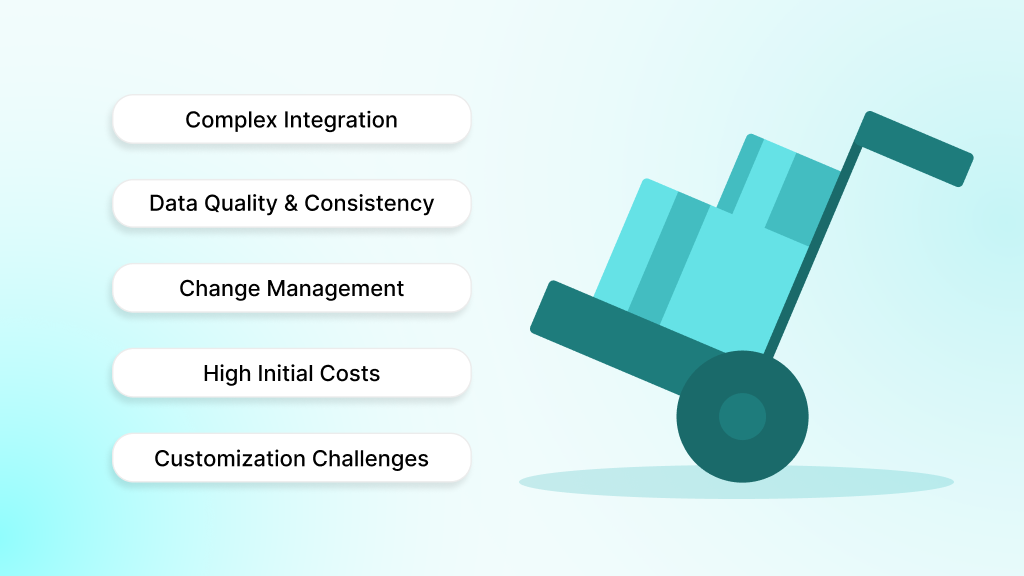
Implementing a Transportation Management System (TMS) presents its own challenges. Understanding these challenges and having clear strategies in place can ease the process and ensure successful adoption. Here are the key obstacles and practical solutions:
1. Complex Integration with Existing Systems
- Challenge: Integrating TMS with legacy systems, such as ERPs and WMSs, can create data silos and lead to integration issues.
- Solution: Collaborate with vendors who have experience in system integration. Utilize API-driven solutions or middleware to connect disparate systems seamlessly.
2. Data Quality and Consistency
- Challenge: TMS requires accurate and consistent data, but many companies struggle with outdated or inconsistent data sources.
- Solution: Perform a data audit and clean-up before integration. Establish ongoing data quality checks to ensure consistency and accuracy.
3. Change Management
- Challenge: Employees may resist adopting a new system, especially if they are used to manual processes.
- Solution: Provide comprehensive training and clearly communicate the benefits. Offer continuous support during the transition.
4. High Initial Costs
- Challenge: The upfront cost of TMS, including software, training, and implementation, can be a barrier for some businesses.
- Solution: Opt for scalable or modular TMS solutions to distribute costs over time. Consider SaaS TMS models for lower initial investment.
5. Customization Challenges
- Challenge: Generic TMS solutions may not effectively address specific business needs, resulting in inefficiencies or workarounds.
- Solution: Opt for a flexible TMS that can be tailored to your business requirements. Work with vendors like DEVtrust, who offer customization options.
By addressing these challenges head-on, you can unlock the full potential of a TMS, improving efficiency and cost-effectiveness in your supply chain operations.
Future Trends for TMS
As customer expectations rise, TMS systems are evolving to meet the increasing demand for speed and efficiency in logistics. Here are the key trends shaping the future of TMS:
- IoT devices enhance real-time fleet monitoring, giving you full visibility into driving conditions and assets while in transit. This enables you to lower fuel costs, improve driver safety, and avoid delays by tracking vehicle performance in real-time.
- Blockchain technology increases transparency and data integrity across your supply chain. It ensures secure transactions and real-time tracking of goods, so you can reduce fraud and enhance trust with all parties involved.
- Cold chain management, powered by IoT and blockchain, ensures the safe handling of temperature-sensitive products. It helps you maintain product integrity, reduce waste, and comply with temperature requirements, ensuring your products are delivered in optimal conditions.
These advancements in TMS are creating new opportunities for TMS to improve efficiency, lower costs, and deliver superior customer service.
Conclusion
Those advantages showcase how TMS optimizes logistics and drives efficiency. From cost savings to enhanced customer service, a robust TMS is crucial for modern supply chains. With features such as real-time tracking, route optimization, and advanced analytics, TMS transforms your logistics operations, enabling better decisions and improved bottom lines.
As these technologies continue to evolve, adopting a custom TMS solution will keep you ahead of the competition. DEVtrust offers tailored TMS solutions that integrate seamlessly with your existing systems. With our expertise, we ensure scalability, flexibility, and data-driven insights for your logistics operations.
Get in touch with us today and take control of your supply chain with a customized TMS built to fit your business needs.
13 Key Advantages of Transportation Management Systems
Explore the advantages of transportation management system. Optimize routes, reduce expenses, and streamline logistics for improved business performance.
Contact Us